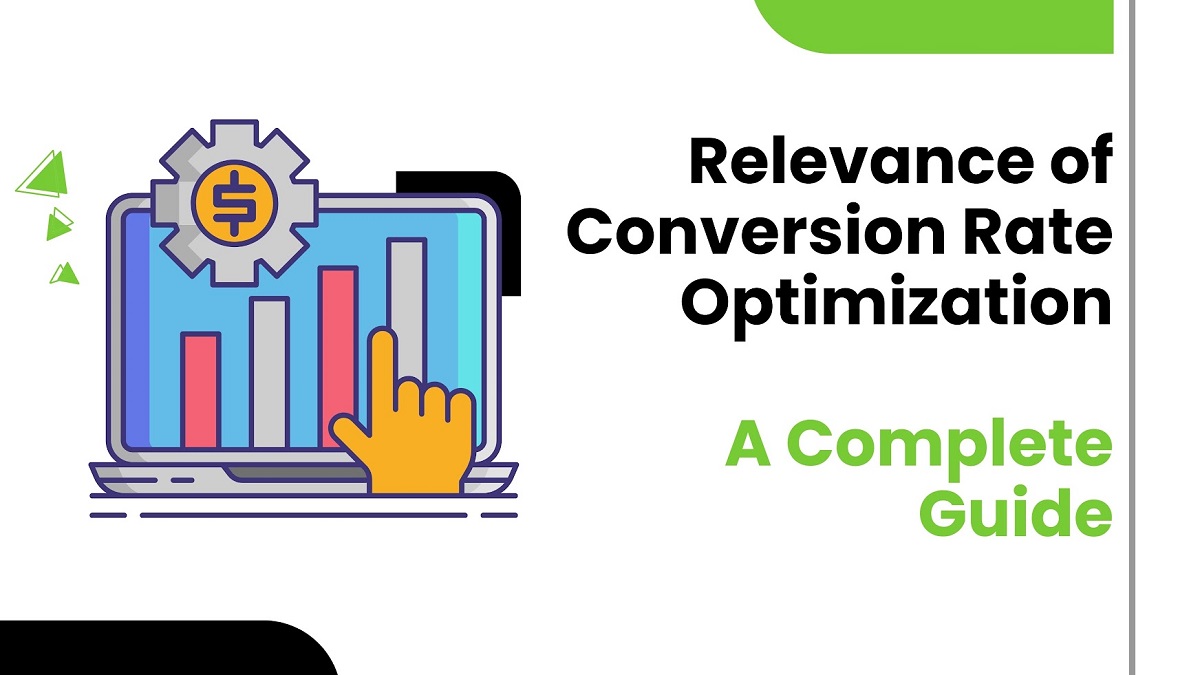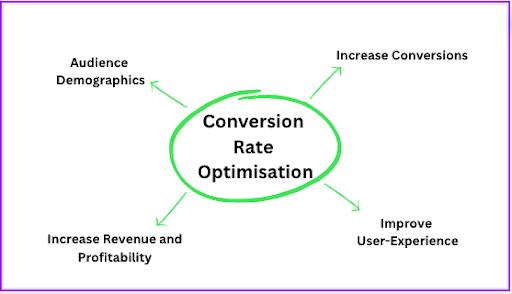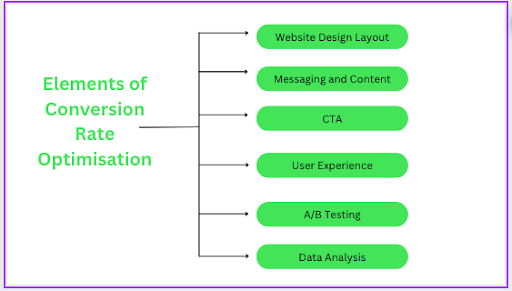Relevance of Conversion Rate Optimization – A Complete Guide

CRO stands for Conversion Rate Optimization. It is optimising a website or digital marketing campaign to improve the percentage of visitors who complete a desired action, such as purchasing, filling out a form, or subscribing to a newsletter.
CRO aims to increase the effectiveness of a website or marketing campaign and ultimately drive more conversions and revenue. This is typically done through user experience design, A/B testing, and data analysis.
Explanation of Conversion Rate Optimization (CRO)
Conversion Rate Optimization (CRO) is optimising a website or marketing campaign to increase the percentage of visitors who take a desired action, such as purchasing, filling out a form, or subscribing to a newsletter.
The ultimate goal of CRO is to increase the effectiveness of a website or marketing campaign, drive more conversions, and improve the overall return on investment (ROI).
The CRO process involves analysing user behaviour and identifying areas of improvement, setting goals and priorities, and making changes to the website or campaign to improve user experience and increase the likelihood of conversion.
This may involve optimising calls-to-action (CTAs), landing pages, forms, and visual design.
Testing and experimentation are also essential aspects of CRO, with A/B testing being a standard method used to compare the effectiveness of different elements and identify the most effective approach.
Continuous monitoring and performance analysis are also necessary to adapt and adjust the optimization plan.
CRO is a data-driven approach to improving the website or campaign performance, intending to increase conversions and drive business success.
By improving the user experience and making it easier for visitors to take the desired action, businesses can improve their ROI and achieve their marketing and sales goals.
Brand Example
One example of a brand that has implemented successful Conversion Rate Optimization (CRO) strategies is Airbnb. The company has used A/B testing to improve the conversion rates of their website and mobile app, and they have also experimented with different pricing and messaging to increase conversions.
For example, Airbnb found that by highlighting the trust and safety of their platform on their homepage, they could increase the number of people who completed a booking. They also tested different variations of their search filters and sorting options to make it easier for users to find the perfect accommodation.
By continually testing and optimising their website and app, Airbnb has improved their conversion rates and generated more revenue for the business.
Importance of CRO
Increasing conversions in the business is the ultimate motive of driving a business forward.
And for that optimising conversions for campaigns is relevant. Let us read more to evaluate why conversion rate optimization is important.

1. Increasing conversions:
The primary goal of CRO is to increase the percentage of visitors who take a desired action on a website or marketing campaign, such as making a purchase or filling out a form.
By optimising elements such as CTAs, landing pages, and forms, businesses can increase the likelihood that visitors will take the desired action, ultimately driving more conversions and improving ROI.
2. Improving user experience:
A well-optimised website or campaign provides a better user experience, making it easier for visitors to find what they’re looking for and take the desired action. This can increase engagement and longer time spent on the site, contributing to higher search engine rankings.
3. Increasing revenue and profitability:
By increasing conversions and improving user experience, businesses can ultimately increase revenue and profitability. This can be achieved through increased sales, higher customer lifetime value, and lower customer acquisition costs.
4. A better understanding of the audience:
The CRO process involves analysing user behaviour and identifying areas of improvement, which can provide valuable insights into audience needs and preferences. This information can be used to improve overall marketing and business strategies.
Let us further read in detail how you can achieve Conversion Rate Optimisation.
Understanding Your Target Audience for CRO
Understanding the target audience is critical for effective Conversion Rate Optimization (CRO) because it provides valuable insights into audience needs and preferences, which can help businesses improve the user experience and increase the likelihood of conversion.
By understanding the target audience:
- Businesses can identify the specific pain points and challenges that their audience is facing, which can help them create more effective messaging and content that speaks directly to their audience’s needs.
- This can improve the overall user experience and make it easier for visitors to find what they want and take the desired action.
- In addition, understanding the target audience can help businesses create more accurate and effective buyer personas, which can inform the optimization process.
- By knowing the audience’s specific demographics, behaviours, and interests, companies can tailor their optimization efforts to better meet the needs and preferences of their target audience.
- Creating a website or marketing campaign that resonates with its intended audience helps drive more conversions. Without a deep understanding of the target audience, businesses may miss the mark with their messaging, design, and optimization efforts, resulting in poor performance and missed growth opportunities.
Analysing Your Website or Campaign for CRO
Analysing your website or campaign for Conversion Rate Optimization (CRO) is the process of examining user behaviour and identifying areas of improvement to increase the likelihood of conversion.
This involves using data analysis tools and techniques to gather information about user behaviour and make informed decisions about optimising a website or marketing campaign for better performance.
Some common techniques for analysing a website or campaign for CRO include:
1. Website traffic analysis:
This involves analysing traffic patterns and user behaviour on a website using tools like Google Analytics to gain insights into how visitors interact with the site, which pages are most popular, and where visitors are dropping off.
2. Heat mapping:
Heat maps visually represent user behaviour on a website, highlighting which areas of a page are most frequently viewed or clicked. This can provide insights into which elements are most effective and which may need to be optimised.
3. User surveys:
Surveys can be used to gather user feedback about their experience on a website or with a marketing campaign, helping identify pain points and areas for improvement.
4. A/B testing:
A/B testing involves comparing two different versions of a website or campaign to see which performs better in conversion rate. This can help identify the most effective elements and inform future optimization efforts.
By analysing website and campaign data, businesses can gain a deeper understanding of user behaviour and identify specific areas for improvement.
This information can inform the CRO process and make data-driven decisions about which optimization efforts will most impact conversion rate and business performance.
Setting Goals and Prioritising Efforts for CRO
Setting goals and prioritising efforts is critical in the Conversion Rate Optimization (CRO) process. Without clear goals and priorities, businesses may waste time and resources on ineffective optimization efforts.
Here are some steps to help companies to set goals and prioritise their CRO efforts:
1. Define goals:
The first step is to clearly define the purposes of the CRO process. What specific actions do you want visitors to take on your website or campaign, and how will you measure success? Goals may include increasing the conversion rate, reducing the bounce rate, or improving engagement.
2. Identify areas for improvement:
Analyse your website or campaign data to identify areas for improvement that align with your goals. This might include optimising CTAs, improving website speed, or simplifying checkout.
3. Prioritize areas for improvement:
Prioritise the areas for improvement based on the potential impact on your goals and the level of effort required to implement the changes.
Some sites may have a high impact but require a significant investment of time and resources, while others may have a lower impact but be relatively easy to implement.
4. Create an optimization plan:
Create a plan for implementing optimization efforts based on your priorities. This may include a timeline, a list of specific changes to be made, and a method for tracking results.
5. Test and measure results:
Once changes have been made, use data analysis tools to track and measure the impact on your goals. Use this information to refine your optimization plan and continue to make improvements over time.
By setting clear goals and prioritising optimization efforts, businesses can focus their resources on the areas that will impact their bottom line. This can help to increase conversion rates, improve user experience, and drive business growth.
After knowing the ways to optimise the conversion rate, let us now read the elements of CRO.
Elements of Conversion Rate Optimization
Conversion Rate Optimization (CRO) is a process that involves improving the user experience on a website or marketing campaign to increase the likelihood of conversion. There are several critical elements of CRO that businesses should focus on to maximise their effectiveness:

1. Website design and layout:
A website’s design and layout can significantly impact user experience and conversion rate. Businesses should create a straightforward, intuitive design that guides users to the desired action.
2. Messaging and content:
The messaging and content on a website should be clear, concise, and tailored to the needs and preferences of the target audience. This can include headlines, copy, and images.
3. Calls to Action (CTAs):
Call to Action (CTAs) are buttons or links that encourage users to take a specific action, such as making a purchase or filling out a form. Businesses should create clear, compelling CTAs prominently displayed on the page.
4. User experience:
User experience encompasses all aspects of how users interact with a website, including navigation, load times, and mobile responsiveness. Optimising the user experience can help to reduce the bounce rate and increase the likelihood of conversion.
5. A/B testing:
A/B testing involves comparing two versions of a website or campaign to see which performs better in conversion rate. This can help identify the most effective elements and inform future optimization efforts.
6. Data analysis:
Data analysis tools can track and measure user behaviour, including traffic patterns, bounce rate, and conversion rate. This information can be used to identify areas for improvement and inform the CRO process.
Businesses can create a website or marketing campaign optimised for maximum conversion rate by focusing on these critical elements of CRO. This can help to increase revenue, improve user experience, and drive business growth.
Why is Testing and Experimentation Relevant for CRO?
A/B testing is an integral part of Conversion Rate Optimization (CRO) that involves comparing two versions of a website or marketing campaign to see which performs better in terms of conversion rate. Here are some reasons why A/B testing is essential:
1. Data-driven decision making:
A/B testing provides businesses with objective, data-driven insights into which elements of their website or campaign are most effective in driving conversion. This can help businesses make informed decisions about optimization efforts.
2. Improved user experience:
A/B testing can help to identify which elements of a website or campaign are most effective in improving user experience.
By making data-driven changes, businesses can create a better user experience that is more likely to lead to conversion.
3. Increased conversion rate:
By identifying and optimising the most effective elements of a website or campaign, businesses can increase their conversion rate and improve their bottom line.
4. Reduced risk:
A/B testing can help to reduce the risk of making significant changes to a website or campaign without knowing whether they will be effective.
By testing changes on a smaller scale, businesses can avoid making costly mistakes and make more informed decisions about optimization efforts.
5. Continuous improvement:
A/B testing is an iterative process that allows businesses to continually test and refine their website or campaign. This can help to ensure that optimization efforts remain effective over time and that businesses stay ahead of the competition.
Implementing Changes and Monitoring Progress of a Website for CRO
Implementing changes and monitoring progress is crucial to the Conversion Rate Optimization (CRO) process.
Once businesses have identified areas for improvement and made changes to their website or marketing campaign, monitoring progress and adjusting strategies as needed is important.
Here are some steps businesses can take to implement changes and monitor progress for CRO:
1. Implement changes:
Once businesses have identified areas for improvement, they should implement the changes and track their effects. This can involve changing website design, content, CTAs, user experience, etc.
2. Track progress:
Data analysis tools can track and measure user behaviour, traffic patterns, bounce rate, and conversion rate.
This information can be used to monitor progress and identify whether the changes positively impact the conversion rate.
3. Analyse results:
Businesses should analyse the data to determine which changes have effectively driven conversion and which have not. This information can be used to refine the optimization strategy and make further improvements.
4. Continue testing and optimization:
A/B testing should be an ongoing process that involves continuous testing and optimization. Businesses should continue to test different elements of their website or marketing campaign to identify new areas for improvement and ensure that optimization efforts remain effective over time.
5. Regular reporting:
Regular reporting and communication are essential to ensure that all stakeholders know progress and that optimization efforts are aligned with business goals.
Conclusion
Conversion Rate Optimization (CRO) is a crucial process that helps businesses improve their website or marketing campaign to increase the chances of conversion.
Understanding the target audience, analysing the website or campaign, and setting goals and priorities are key elements of CRO.
If you are trying to improve business revenue with better performance, you can write to us hello[at]noboruworld.com. We have a team of experienced professionals who can drive results for your business.





Comments
Helpful blog
We stumbled over here from a different page and thought I
should check things out. I like what I see so i am just following you.
Look forward to finding out about your web page yet again.
Also visit my blog post :: Ron Spinabella
I positively adore your creating design; it’s so engaging.
This is among the very best articles I have actually reviewed in an even though.
Thanks for sharing!
My page; Ron Spinabella